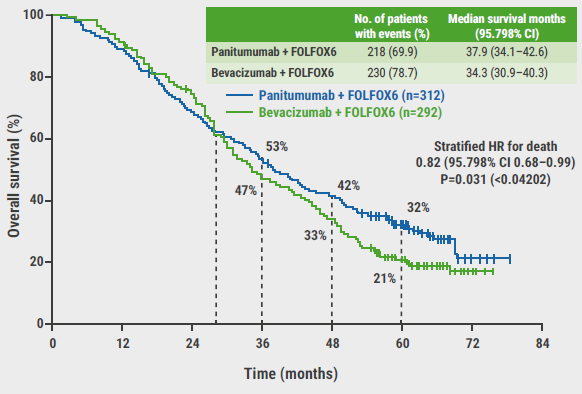https://doi.org/10.55788/513ee88a
Dr Sara Lonardi (Veneto Institute of Oncology, Italy) presented the results from the multicentre, open-label CheckMate 8HW trial (NCT04008030) [1]. Patients with histologically confirmed unresectable or metastatic microsatellite instability-high/mismatch repair-deficient (MSI-H/dMMR) CRC and an ECOG performance status of 0 or 1 were enrolled and randomly assigned to 3 arms: nivolumab monotherapy (n=202), nivolumab plus ipilimumab (n=202), or chemotherapy (n=101).
The dual primary endpoints were progression-free survival (PFS) in the nivolumab/ipilimumab arm versus chemotherapy arm across the frontline setting, and PFS in the nivolumab/ipilimumab arm versus nivolumab monotherapy arm across all treatment lines. Secondary endpoints included safety, overall survival, overall response rate, and HRQoL.
Findings from the interim analysis revealed that the median PFS was not reached with the nivolumab/ipilimumab combination versus 5.9 months with chemotherapy (HR 0.21; 97.91% CI 0.13-0.35; P<0.0001). The 12-month PFS rates were 79% for nivolumab/ipilimumab versus 21% for chemotherapy, and 24-month rates were 72% versus 14% [2].
HRQoL assessments indicated that the nivolumab combination improved global health status starting at week 13 and surpassed the trial’s prespecified minimally important difference (MID) threshold at week 13, with a least squares mean difference of 9.7 (95% CI 3.6–15.9) [1]. By week 21, significant improvements in global health status with nivolumab/ipilimumab were observed.
The nivolumab/ipilimumab combination also demonstrated improvements in physical, role, and social functioning based on the EORTC QLQ-C30 assessment. The least squares mean differences between the nivolumab/ipilimumab and chemotherapy arms were 10.6 for global health status, 7.3 for physical functioning, 12.0 for role functioning, and 9.6 for social functioning. Symptoms severity, measured by the EORTC QLQ-CR29, showed reductions in fatigue (-16.8), nausea and vomiting (-4.3), and pain (-7.8) with nivolumab/ipilimumab compared with chemotherapy (see Figure).
Figure: Quality-of-life improved with nivolumab/ipilimumab in CheckMate 8HW [2]

The rate of global health status deterioration was lower in the nivolumab/ipilimumab arm compared with chemotherapy (HR 0.32; 95% CI 0.18–0.57). Deterioration in physical functioning (HR 0.49; 95% CI 0.26–0.94), role functioning (HR 0.50; 95% CI 0.29–0.87), social functioning (HR 0.54; 95% CI 0.28–1.04), and fatigue (HR 0.50; 95% CI 0.31–0.80) was also less frequent.
Dr Lonardi concluded: “These HRQoL results provide further support for the use of first-line nivolumab and ipilimumab in MSI-H/dMMR mCRC.”
- Lonardi S, et al. Health-related quality of life (HRQoL) with first-line (1L) nivolumab (NIVO) plus ipilimumab (IPI) vs chemotherapy (chemo) in patients (pts) with microsatellite instability-high (MSI-H)/mismatch repair-deficient (dMMR) metastatic colorectal cancer (mCRC): CheckMate 8HW. Abstract 2O, ESMO Gastrointestinal Cancers Congress 2024, 26–29 June, Munich, Germany.
- Lenz H-J, et al. J Clin Oncol 2024;42:16S_3503.
Copyright ©2024 Medicom Medical Publishers
Posted on
Previous Article
« Sequence effect for third-line treatment of mCRC Next Article
New analyses validate TAP and CPS scores for PD-L1 expression »
« Sequence effect for third-line treatment of mCRC Next Article
New analyses validate TAP and CPS scores for PD-L1 expression »
Related Articles

August 10, 2021
ECCO 2021 Highlights Podcast

© 2024 Medicom Medical Publishers. All rights reserved. Terms and Conditions | Privacy Policy
HEAD OFFICE
Laarderhoogtweg 25
1101 EB Amsterdam
The Netherlands
T: +31 85 4012 560
E: publishers@medicom-publishers.com

